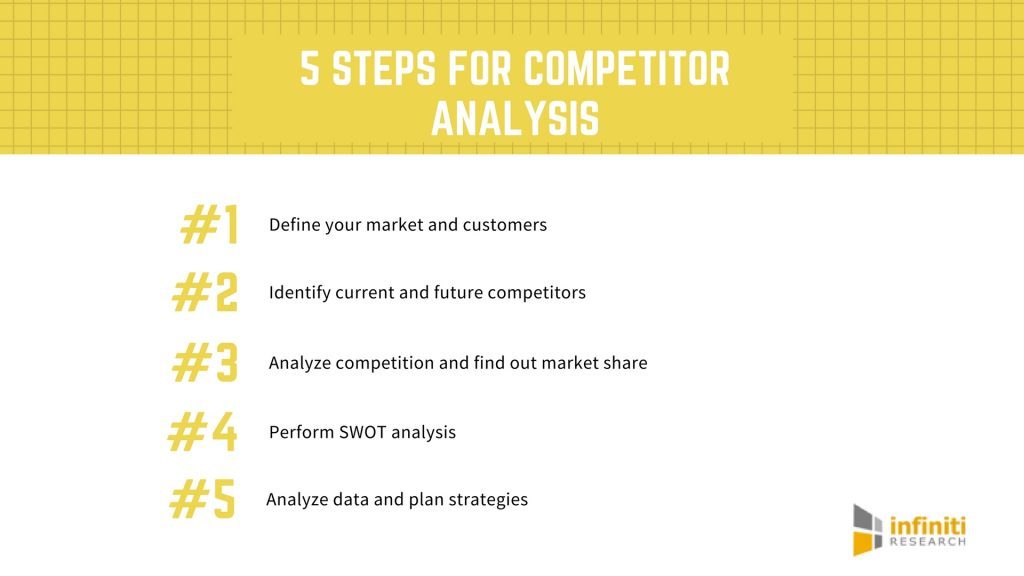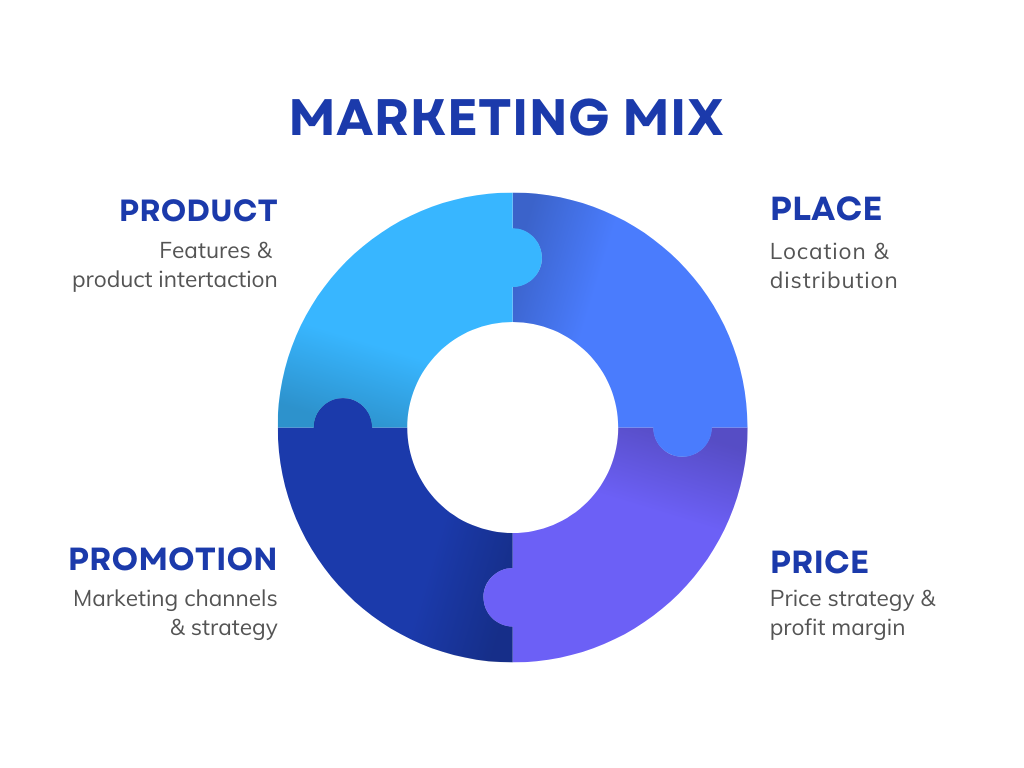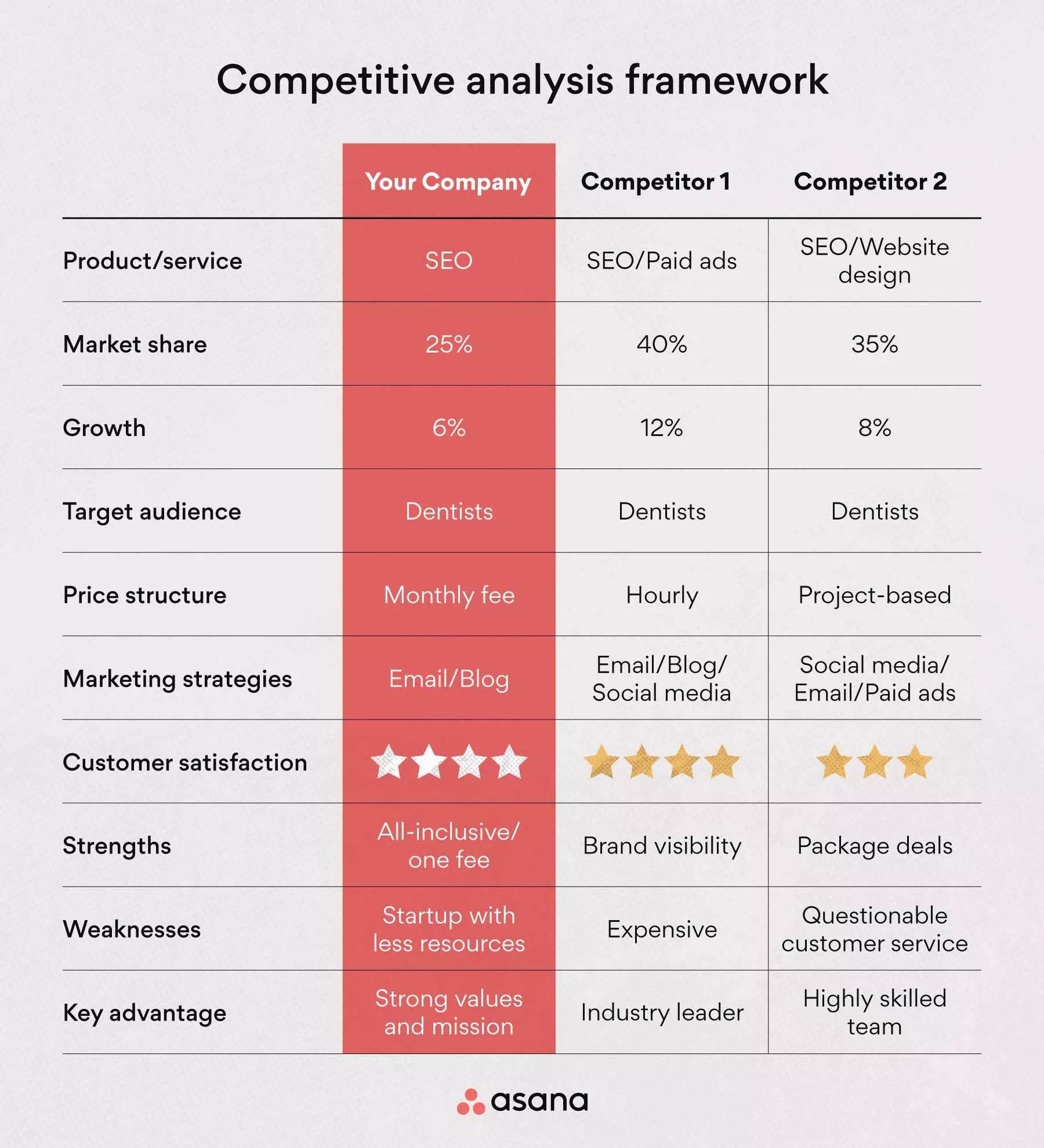Understanding your competition is a critical step in crafting a successful business strategy. A thorough competitor analysis provides valuable insights into market trends, strengths, weaknesses, and opportunities, enabling you to make informed decisions and stay ahead in your industry. In this step-by-step guide, we’ll walk you through the process of conducting a comprehensive competitor analysis. From identifying key competitors to evaluating their strategies and performance, this guide will equip you with the tools and techniques needed to gain a competitive edge. Whether you’re a startup or an established business, this approach will help you refine your positioning and achieve long-term success.
My Step-by-Step Guide for a Competitor Analysis
Competitor analysis is a crucial process for understanding your market position and identifying opportunities to outperform your rivals. By systematically evaluating your competitors, you can uncover their strengths, weaknesses, strategies, and customer perceptions. This guide will walk you through the essential steps to conduct a thorough competitor analysis.
See Also What are some direct-to-consumer brands that you admire and why?
What are some direct-to-consumer brands that you admire and why?1. Identify Your Competitors
The first step in competitor analysis is to identify who your competitors are. Start by categorizing them into direct competitors (those offering similar products or services) and indirect competitors (those offering alternative solutions to the same problem). Use tools like Google Search, industry reports, and social media to compile a comprehensive list.
| Type | Description |
|---|---|
| Direct Competitors | Companies offering similar products or services. |
| Indirect Competitors | Companies providing alternative solutions to the same customer needs. |
2. Analyze Competitors' Products and Services
Once you’ve identified your competitors, analyze their products and services. Look at their features, pricing, quality, and unique selling points (USPs). This will help you understand what makes them stand out and where there might be gaps in the market.
See Also Looking for Real Life Marketing/Communications Examples for a Class I'm Teaching!
Looking for Real Life Marketing/Communications Examples for a Class I'm Teaching!| Aspect | Details to Analyze |
|---|---|
| Features | What functionalities do their products offer? |
| Pricing | How do their prices compare to yours? |
| Quality | What is the perceived quality of their offerings? |
| USPs | What makes their products unique? |
3. Evaluate Competitors' Marketing Strategies
Understanding your competitors' marketing strategies is key to identifying their strengths and weaknesses. Examine their advertising channels, social media presence, content marketing, and SEO strategies. Tools like SEMrush or Ahrefs can provide insights into their online performance.
| Strategy | Details to Evaluate |
|---|---|
| Advertising Channels | Where do they advertise (e.g., Google Ads, Facebook)? |
| Social Media Presence | How active are they on platforms like Instagram or LinkedIn? |
| Content Marketing | What type of content do they produce (blogs, videos)? |
| SEO Strategies | What keywords are they targeting? |
4. Assess Competitors' Strengths and Weaknesses
Conduct a SWOT analysis (Strengths, Weaknesses, Opportunities, Threats) for each competitor. This will help you identify areas where you can outperform them and potential threats they pose to your business.
See Also What Are Some Direct-to-Consumer Brands That You Admire and Why?
What Are Some Direct-to-Consumer Brands That You Admire and Why?| SWOT Element | Description |
|---|---|
| Strengths | What do they do well? |
| Weaknesses | Where do they fall short? |
| Opportunities | What market opportunities can you exploit? |
| Threats | What risks do they pose to your business? |
5. Monitor Competitors' Customer Feedback
Customer feedback is a goldmine of information. Analyze reviews, ratings, and social media comments about your competitors. This will give you insights into what customers love and dislike about their products or services.
| Source | Details to Monitor |
|---|---|
| Reviews | What are customers saying on platforms like Yelp or Trustpilot? |
| Ratings | How do their products or services rate compared to yours? |
| Social Media Comments | What feedback are they receiving on platforms like Twitter or Facebook? |
How to do competitor analysis step by step?

 What Do Digital Marketers Exactly Do? What Does a Workday Look Like?
What Do Digital Marketers Exactly Do? What Does a Workday Look Like?1. Identify Your Competitors
To begin a competitor analysis, you must first identify who your competitors are. This includes both direct competitors (businesses offering similar products or services) and indirect competitors (businesses offering alternative solutions to the same problem).
- Conduct market research to find businesses targeting the same audience.
- Use tools like Google Search, social media, and industry reports to compile a list.
- Categorize competitors based on their size, market share, and relevance to your business.
2. Analyze Competitors' Products and Services
Understanding what your competitors offer is crucial. Examine their product features, pricing strategies, and unique selling propositions (USPs).
- Review their websites, product catalogs, and customer reviews.
- Compare the quality, variety, and pricing of their offerings to yours.
- Identify any gaps or opportunities in their product lines.
3. Evaluate Competitors' Marketing Strategies
Analyzing how competitors market their products can provide insights into their brand positioning and customer engagement tactics.
- Study their social media presence, content marketing, and advertising campaigns.
- Analyze their messaging, tone, and visual branding.
- Identify the platforms they use and how effectively they engage with their audience.
4. Assess Competitors' Strengths and Weaknesses
Understanding your competitors' strengths and weaknesses helps you identify areas where you can outperform them.
- Conduct a SWOT analysis (Strengths, Weaknesses, Opportunities, Threats) for each competitor.
- Look for patterns in customer feedback, such as recurring complaints or praises.
- Identify operational inefficiencies or areas where they excel.
5. Monitor Competitors' Online Presence and Reputation
Tracking your competitors' online presence and reputation can reveal valuable insights into their customer relationships and market position.
- Use tools like Google Alerts, social listening platforms, and review sites to monitor their activity.
- Analyze their website traffic, search rankings, and backlink profiles.
- Pay attention to how they handle customer complaints and feedback.
What are the 5 steps parts of a competitive analysis?

1. Identify Your Competitors
To begin a competitive analysis, the first step is to identify your competitors. This involves determining both direct and indirect competitors in your industry. Direct competitors offer similar products or services, while indirect competitors provide alternatives that satisfy the same customer needs. Here’s how to approach this step:
- List businesses that offer similar products or services.
- Research companies that target the same customer base.
- Analyze emerging competitors or startups in your niche.
2. Analyze Competitors’ Products and Services
The second step focuses on analyzing competitors’ products and services. This involves evaluating their offerings to understand their strengths and weaknesses. Key aspects to consider include:
- Product features, quality, and pricing.
- Unique selling propositions (USPs) that differentiate them.
- Customer reviews and feedback on their offerings.
3. Evaluate Competitors’ Marketing Strategies
Understanding how competitors market their products is crucial. This step involves evaluating competitors’ marketing strategies to identify what works and what doesn’t. Key areas to examine include:
- Their social media presence and engagement.
- Advertising campaigns and channels used.
- Content marketing efforts, such as blogs or videos.
4. Assess Competitors’ Strengths and Weaknesses
In this step, you assess competitors’ strengths and weaknesses to identify opportunities and threats. This analysis helps you understand where competitors excel and where they fall short. Consider the following:
- Financial stability and market share.
- Customer loyalty and brand reputation.
- Operational efficiency and innovation capabilities.
5. Identify Opportunities and Threats
The final step involves identifying opportunities and threats based on your analysis. This helps you develop strategies to capitalize on market gaps or mitigate risks. Key considerations include:
- Market trends and customer needs not being addressed.
- Potential threats from new entrants or technological advancements.
- Areas where your business can outperform competitors.
How do you write a competitive analysis?
What is a Competitive Analysis?
A competitive analysis is a strategic assessment of your competitors' strengths and weaknesses relative to your own business. It helps identify opportunities and threats in the market. To conduct one:
- Define your industry and the market segment you are targeting.
- Identify your competitors, both direct and indirect.
- Analyze their products, pricing, and marketing strategies.
How to Identify Your Competitors
Identifying competitors is a critical step in writing a competitive analysis. Focus on both direct and indirect competitors:
- Direct competitors offer similar products or services to the same target audience.
- Indirect competitors provide alternative solutions to the same customer needs.
- Use tools like Google Search, social media, and industry reports to find competitors.
What Information to Include in a Competitive Analysis
A comprehensive competitive analysis should include the following elements:
- Company overview: Basic information about each competitor.
- Product or service analysis: Features, quality, and pricing comparisons.
- Market position: Competitors' market share and brand reputation.
How to Analyze Competitors' Strengths and Weaknesses
To analyze competitors effectively, focus on their strengths and weaknesses:
- Strengths: Identify what they do well, such as strong branding or superior customer service.
- Weaknesses: Look for gaps, such as poor online presence or limited product offerings.
- Use tools like SWOT analysis to structure your findings.
How to Use Competitive Analysis to Improve Your Strategy
Once you have gathered and analyzed the data, use it to refine your business strategy:
- Identify opportunities: Find areas where competitors are underperforming.
- Mitigate threats: Address potential risks posed by competitors.
- Leverage strengths: Highlight what makes your business unique and competitive.
What are the 4ps of competitive analysis?

Understanding the 4Ps of Competitive Analysis
The 4Ps of competitive analysis refer to a framework used to evaluate and compare competitors in a market. These 4Ps stand for Product, Price, Place, and Promotion. This model helps businesses identify their strengths and weaknesses relative to competitors, enabling them to make informed strategic decisions.
- Product: Analyze the features, quality, and uniqueness of competitors' offerings.
- Price: Compare pricing strategies and how they align with market expectations.
- Place: Examine distribution channels and accessibility of competitors' products.
- Promotion: Evaluate marketing tactics and communication strategies used by competitors.
Why the 4Ps Framework is Essential for Competitive Analysis
The 4Ps framework is a cornerstone of competitive analysis because it provides a structured approach to understanding market dynamics. By breaking down competitors' strategies into these four categories, businesses can identify gaps and opportunities in the market.
- Helps in identifying competitive advantages and disadvantages.
- Provides insights into customer preferences and market trends.
- Enables businesses to refine their marketing mix for better positioning.
How to Analyze the Product Aspect in Competitive Analysis
When analyzing the Product aspect, focus on the features, quality, and value proposition of competitors' offerings. This step is crucial to understanding how your product stacks up against others in the market.
- Compare product features and functionalities.
- Assess the quality and durability of competitors' products.
- Evaluate the unique selling points (USPs) that differentiate their products.
Evaluating Pricing Strategies in Competitive Analysis
The Price component of the 4Ps involves analyzing competitors' pricing models and how they align with market expectations. This step helps businesses determine whether they are overpricing or underpricing their products.
- Compare price points across competitors.
- Analyze discounts, promotions, and payment options offered.
- Understand the perceived value of competitors' pricing strategies.
Assessing Place and Promotion in Competitive Analysis
The Place and Promotion aspects focus on how competitors distribute their products and communicate with their target audience. These elements are critical for understanding market reach and customer engagement.
- Examine distribution channels such as online platforms, retail stores, or partnerships.
- Evaluate marketing campaigns, including social media, advertising, and public relations efforts.
- Analyze the effectiveness of competitors' brand messaging and customer outreach.
Frequently Asked Questions from Our Community
What is the purpose of a competitor analysis?
A competitor analysis is a strategic process that helps businesses understand their market landscape by identifying and evaluating their competitors. The primary purpose is to gain insights into competitors' strengths, weaknesses, strategies, and market positioning. This information allows businesses to identify opportunities, mitigate threats, and refine their own strategies to gain a competitive advantage. By analyzing competitors, companies can make informed decisions, improve their offerings, and better meet customer needs.
What are the key steps in conducting a competitor analysis?
Conducting a competitor analysis involves several key steps. First, identify your competitors, both direct and indirect. Next, gather data on their products, pricing, marketing strategies, and customer feedback. Then, analyze their strengths and weaknesses using tools like SWOT analysis. After that, evaluate their market positioning and target audience. Finally, use the insights gained to identify gaps in the market and refine your own business strategy. Each step is crucial for building a comprehensive understanding of the competitive landscape.
What tools can I use to perform a competitor analysis?
There are several tools available to assist in performing a competitor analysis. Popular options include SEMrush and Ahrefs for analyzing competitors' online presence and SEO strategies. Social media monitoring tools like Hootsuite or Brandwatch can help track competitors' engagement and content strategies. Additionally, Google Alerts can notify you of competitors' updates, while SimilarWeb provides insights into their website traffic and user behavior. These tools streamline data collection and provide actionable insights for your analysis.
How often should I conduct a competitor analysis?
The frequency of conducting a competitor analysis depends on your industry and market dynamics. In fast-paced industries like technology or fashion, it’s advisable to perform an analysis quarterly or even monthly to stay updated on competitors' moves. For more stable industries, a biannual or annual review may suffice. Regularly updating your analysis ensures you remain aware of market trends, emerging competitors, and shifts in consumer preferences, allowing you to adapt your strategies proactively.
Leave a Reply


Articles of interest